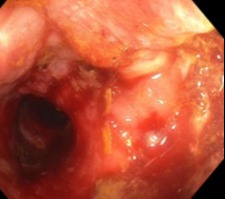Sunday Poster Session
Category: Colon
P0211 - Signet Cell Carcinoma of the Rectum Disguised as Recurrent Horseshoe Perianal Abscess: A Case Report
Sunday, October 22, 2023
3:30 PM - 7:00 PM PT
Location: Exhibit Hall

Has Audio

Maria Camila Fonseca, MD
New York Health and Hospitals/Woodhull Hospital
Brooklyn, NY
Presenting Author(s)
Maria Camila Fonseca, MD1, Joanna Lenik, MD2, Yvette Achue-Egbe, MD3, Lyam Ciccone, MD2, Gulam Khan, MD4
1New York Health and Hospitals/Woodhull Hospital, Brooklyn, NY; 2NYC Health + Hospitals/Metropolitan Hospital, Manhattan, NY; 3NYC Health + Hospitals/Metropolitan, Manhattan, NY; 4NYC Health and Hospitals/Woodhull Hospital, Brooklyn, NY
Introduction: Colorectal Signet cell carcinoma (SRCC) is a rare but aggressive entity, diagnosed at advanced stages when compared to other colon cancers. The presentation includes bloody stools, weight loss or bowel habit changes [1]. There are no reported cases of recurrent perianal abscess. We present the case of a female with recurrent horseshoe perianal abscess, diagnosed with Signet cell carcinoma of the rectum.
Case Description/Methods: A 53-year-old female with a history of rectal bleeding and 25Ibs weight loss in 3 months, presented for recurrent rectal pain. One exam was noted to have an ischioanal abscess and a rectal mass. CT showed a possible recto-vaginal fistula. She underwent a colonoscopy which showed inflammation with significant rectal stenosis and mass (figure 1). Pelvic MRI demonstrated anorectal thickening and mesorectal and external iliac lymphadenopathy (T4b, N2, M1a stage). Histology resulted in invasive poorly differentiated adenocarcinoma with signet ring cells. Due to significant inflammation, the etiology of the iliac lymphadenopathy was unclear, confounding staging. Due to the proximity of the external iliac artery and ongoing infection, a biopsy of the lymph nodes was not feasible. The condition was staged as T3bN2. Localized reduction therapy with Xeloda/Oxaliplatin was started, with diverting loop colostomy while preparing for radiation prior to definitive surgery.
Discussion: Colorectal SRCC has been poorly defined mostly due to its rare occurrence among all Colorectal cancers. For diagnosis, it must contain >50% of Signet ring cells with immature glands and anaplastic and undifferentiated cells with diffuse infiltration [2]. The highest prevalence is among men in the 4th decade of life, and presents with changes in bowel habits, and bleeding. It is associated with elevated CEA, and in most cases at the time of diagnosis is metastatic, with an estimated survival rate of 30 months [2]. Although most features are present in our patient, the female sex raises concerns about hormonal factors attributing to a much more aggressive pathology. Perianal abscesses are recurrent due to an ongoing silent malignancy and could have increased staging in MRI due to local inflammation.
Lessons gleaned: Infiltrative condition of SRCC and conversion to friable tissue increase the likelihood of recurrent local infections without appropiate healing. This aggressive cancer must be suspected if concomitantly rectal bleeding and weight loss are present.
1New York Health and Hospitals/Woodhull Hospital, Brooklyn, NY; 2NYC Health + Hospitals/Metropolitan Hospital, Manhattan, NY; 3NYC Health + Hospitals/Metropolitan, Manhattan, NY; 4NYC Health and Hospitals/Woodhull Hospital, Brooklyn, NY
Introduction: Colorectal Signet cell carcinoma (SRCC) is a rare but aggressive entity, diagnosed at advanced stages when compared to other colon cancers. The presentation includes bloody stools, weight loss or bowel habit changes [1]. There are no reported cases of recurrent perianal abscess. We present the case of a female with recurrent horseshoe perianal abscess, diagnosed with Signet cell carcinoma of the rectum.
Case Description/Methods: A 53-year-old female with a history of rectal bleeding and 25Ibs weight loss in 3 months, presented for recurrent rectal pain. One exam was noted to have an ischioanal abscess and a rectal mass. CT showed a possible recto-vaginal fistula. She underwent a colonoscopy which showed inflammation with significant rectal stenosis and mass (figure 1). Pelvic MRI demonstrated anorectal thickening and mesorectal and external iliac lymphadenopathy (T4b, N2, M1a stage). Histology resulted in invasive poorly differentiated adenocarcinoma with signet ring cells. Due to significant inflammation, the etiology of the iliac lymphadenopathy was unclear, confounding staging. Due to the proximity of the external iliac artery and ongoing infection, a biopsy of the lymph nodes was not feasible. The condition was staged as T3bN2. Localized reduction therapy with Xeloda/Oxaliplatin was started, with diverting loop colostomy while preparing for radiation prior to definitive surgery.
Discussion: Colorectal SRCC has been poorly defined mostly due to its rare occurrence among all Colorectal cancers. For diagnosis, it must contain >50% of Signet ring cells with immature glands and anaplastic and undifferentiated cells with diffuse infiltration [2]. The highest prevalence is among men in the 4th decade of life, and presents with changes in bowel habits, and bleeding. It is associated with elevated CEA, and in most cases at the time of diagnosis is metastatic, with an estimated survival rate of 30 months [2]. Although most features are present in our patient, the female sex raises concerns about hormonal factors attributing to a much more aggressive pathology. Perianal abscesses are recurrent due to an ongoing silent malignancy and could have increased staging in MRI due to local inflammation.
Lessons gleaned: Infiltrative condition of SRCC and conversion to friable tissue increase the likelihood of recurrent local infections without appropiate healing. This aggressive cancer must be suspected if concomitantly rectal bleeding and weight loss are present.

Figure: Rectal mass and stenosis
Disclosures:
Maria Camila Fonseca indicated no relevant financial relationships. Joanna Lenik indicated no relevant financial relationships. Yvette Achue-Egbe indicated no relevant financial relationships. Lyam Ciccone indicated no relevant financial relationships. Gulam Khan indicated no relevant financial relationships.
Maria Camila Fonseca, MD1, Joanna Lenik, MD2, Yvette Achue-Egbe, MD3, Lyam Ciccone, MD2, Gulam Khan, MD4. P0211 - Signet Cell Carcinoma of the Rectum Disguised as Recurrent Horseshoe Perianal Abscess: A Case Report, ACG 2023 Annual Scientific Meeting Abstracts. Vancouver, BC, Canada: American College of Gastroenterology.

